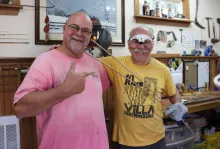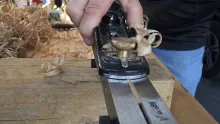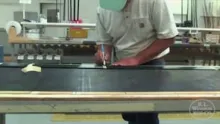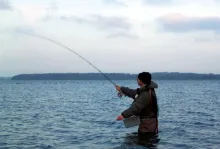The first part of the Global Flyfisher article series on building your own graphite fly rod, which takes you by the hand from the very beginning of the process: identifying and selecting the parts and materials you need.
|
|
This is an article about the materials needed to build a fly rod and a basic “how to” guide – illustrated by the building of a rod.
If you – when you have finished reading these articles - seriously consider building your own custom rod, and consider it a better solution than buying, you have been infected with a positive virus in my point of view. And I have hopefully done a good job in at least one respect...
Foreword
The advantages I personally see in building your own rod after having finished a couple of them, are the quality you can put in your rod and the opportunity to tune this piece of equipment to your own specific needs and your preferred look.
Forget the argument so often heard about saving money when building your own rod(s). You will most probably need some tools you did not have before, and in many situations you will go with higher grade components, which will eliminate the advantage in costs you might have had compared to buying the blank and cheap components. And I forgot one point: It is also lots of fun to create something step by step, which you can use later on in your real fishing life.
Blank manufacturers
There are a lot of manufacturers out there, which are serving the custom builder’s rod market. Most people know some of them from their regular rod- and product lines, some are solely available for the custom market and in this way not that known to a broader public. Others are almost completely hidden, working just as OEM manufacturers for some brands, working solely as development, marketing and distribution companies.
Up until now I have worked in building projects on blanks from Batson, Fibatube, Loomis, Sage, St Croix and Temple Fork Outfitters (TFO). All have good blanks on the market. But there are also lots of other well reputed manufacturers out there like CTS, Lamiglas, Thomas & Thomas, Pacific Bay, Orvis, Scott and many more, which I am curious to use one day.
Which blank suits you?
The most difficult task is to decide on the right rod blank. To bring your final decision as far as possible away from the lottery method we need certain basic facts to start from.
Based on target species and their environment we will decide on a certain rod length and line class. Try to test cast as many models, which would suit your application in regard of length, line class and number of sections, and which are available as a blank.
You will have chances to do this when you go fishing together with friends who will borrow you their rod for just a few casts. A well assorted tackle shop with a nice staff or a fly fishing fair could also be a good opportunity to find out, which blank would suit you.
Today many manufacturers offer their blanks in different configurations with regards to the transportation length: You can buy the same specific rod model (class and length) e.g. in a two and a three section version or a two and a four section version. This will cause slightly different blank layouts, which in some cases will end up in two entirely different rods despite the fact that they are both labelled with same model name, line class and length! Keep this in mind during the process of test casting. I myself learned this the hard way.
Rods which come in a larger number of pieces are easier to transport than the good old two-section versions. Personally I prefer three- or four-piece rods due to the ease of transportation and storage, both on aircraft and while fishing with a spare rod completely hidden in the trunk of a car. Rods in more than four pieces is going a little too much in the direction of a puzzle, but this is only my personal point of view.
Also check the warranties, which many blank manufacturers offer today and compare them with each other. These go from a 30 day warranty (please finish your rod quickly and try to break it within the warranty period) and goes up to life time warranties for the first owner.
The other components
You also have to decide on a reel seat, a handle, some guides, a tip top and maybe a hook rest. Furthermore you will need some thread to wrap the guides to the blank and some coating to seal the wrappings. Following some of my own thoughts with regard to the different components, which are required.
Reel seat
There are several good manufacturers out there. I have used Batson, Pacific Bay, Struble and REC for my own projects with good results
I would like to put them into the following basic categories:
Full Aluminium with anodised surfaces. This will be the best reel seat for all saltwater applications and for heavy freshwater applications or for use under difficult circumstances like long boat trips where a wooden reel seat parts might suffer too much. Standard colours for anodizing are black, grey, chrome and blue. Also capable for saltwater environment I think are reel seats with carbon spacers. Assembled correctly they will also last as long as the ones made from one piece of aluminium.
Nickel Silver plated reel seats with wooden spacers. Some of these reel seats look very nice; the combination of exotic woods with the bright silver colour of the hardware can be a very nice contrast. Something for lighter rods, mainly for freshwater usage. The choice of woods for the spacers is almost endless.
Aluminium hardware, anodised and with a wooden spacer. This is a mixture between the above mentioned versions. Usually a little cheaper than the Nickel Silver plated ones. Black hardware and wood is a popular material combination.
|
|
|
Cork
Jan-Ole Willers gff/>
Handle and fighting butt
Handles and fighting butts are available in different shapes, materials and qualities. Most common materials used for handles are
Cork. Best choice for handles in my point of view. Natural product harvested from cork oaks, mainly in Portugal. Lightweight and easy to shape. Due to rising demand it becomes increasingly difficult to get a real first quality cork rings.
Burl Cork. Mixture of cork pieces of different sizes and rubber, available in different colours. Can be a good choice to give some colourful accents to the rod. Cheaper than most normal cork for obvious reasons.
Rubber Cork. Mixture of cork granulates and rubber. Higher rubber content than burl to achieve better dampening characteristics. Perfect material for “framing” the handle for durability reasons and as a material for fighting butt ends. Heavier than cork and burl-cork.
Eva-foam. Is available in many different colours to match e.g. the blank colours and from my point of view not the first choice for complete fly rod handles, but a very good choice for fighting butt ends or whole fighting butts on heavier saltwater rods.
Preformed handles are available from different manufacturers – on a similar “quality” level as handles on many factory-built rods. So you can buy a pre-shaped handle, ream the bore to fit the blank and put it on your rod. An acceptable choice if you really like the shape and size of the specific handle. Most of them are too short for my taste.
Or you go the hard way building your own handle exactly according to your needs. From my point of view this is a core point of custom rod building and very important especially for a fly rod: While using a fly rod you will always have the handle in your hand, and if it's a one hand fly rod all the force is transferred through one of your hands to the rod – and the other way round.
A handle, which is too short or too thin or thick can turn a wonderful day of fishing into a day in pre-hell because the handling of the rod becomes very exhausting. To find out which length, diameter and shape will suit your needs and your hand best, simply check different handles in the next fly shop or check some of your own fly rods where you might already have a preference for one specific handle.
Just to underline the above: I have a factory built rod, which I do not like to use any longer because the handle is simply too thin for my taste. I feel my hand in such an inconvenient way after a short time using this rod, that it is now a backup rod only.
Handle shapes
Two major points influence the choice of handle shape: personal preference and line class.
The personal preference for a certain way of holding the rod might influence your choice of style. If you cast with the index finger along the handle, straightened shapes like cigar or half wells are a good choice. If you hold the rod with thumb forward a thin Half Wells or a Cigar will not be the first choice.This grip is better on a Full Wells handle where you can use the force of your thumb all day long, casting in the heavier classes.
Cigar: Most common for the lower line classes, between class 0 and 5 but some use it even on really heavy rods. Allows different styles of holding the rod.
Reverse Half Wells: Is a standard grip you find mainly between class 3 and 6.
Full Wells: Common from class 6 or 7 and upwards. From class 9 on the Full Wells handle is sometimes completed with an with an additional front grip starting a bit in front of the main handle.
Hook keeper
Go for one if you like them or if you are one of those who use the handle as a rest for the hook. The hook rest will extend the life of your rod handle.
There are two types available: the wide u-shape style and the foldable version. The latter might be a good choice if you have problems with the standard shape due to line getting caught in the hook rest on regular basis.
I personally do not like them too much. The last rod I put one on was for a small boy to avoid accidents while he is walking along the river with the rigged rod.
Guides
Jan-Ole Willers gff/>
Guides and Tops
There are three types of guides on a fly rod. Counting from the handle to the tip of the rod they are:
Stripping guides: Depending on rod length and class you use one, two or three stripping guides with ceramic inserts on a single hand fly rod. Silicium Carbide (Sic), Aluminium Oxide or Zirconium e.g. are suitable amongst others. Most common shape for stripping guides is the three legged casting rod style guide but two legged versions (a little similar to the snake guide design) can be a good choice too.
Running guides: The choice is between classic snake guides and the more modern single foot guides. Also available are single foot guides with ceramic inserts.
In the following case I will use a special version of the single foot guide: the stand out snake guide. Their advantages are clearly visible in the picture – a sticking of the wet line to the blank is almost impossible. Also the possibility of friction between blank and line during the shooting process is reduced seriously. Disadvantages are the possibility of easier breakage due to their more exposed shape and the possibility of a certain torque forcing the blank. Stand outs have their legitimation on coastal and stillwater rods but are a bad choice for a small creek rods where a guide might end up somewhere between a tree and a bush.
Tip tops: The choice is between classic style wire frame loops and tip tops with ceramic inserts. I have made good experiences with tops with ceramic inserts. Formerly I was hesitant to use them due to their weight. But then I put both types on a weighing scale, and at least the Fuji Concept ceramic tops I use, were similar in weight to the standard type wire style top. You can even hear - or better said: not hear - the advantage of the tip top with ceramic insert while your line is shooting. The reduced sound due to less friction with a ceramic guide is significant.
The size of the tip top’s eye is decisive for the casting performance in my point of view: too small will disturb the shooting process, too big will not direct the line in a straight way. Choose the tip top tube size carefully according to the diameter of the tip of your blank.
Guide material and plating
There are many different materials available used as a plating for the guides. The main task of the plating is to protect the surface against environmental influences and avoid corrosion. With the non ceramics, the smoothness of the surface should be improved the same time for obvious reasons. Following you have some information about the most commonly used types.
Hard Chrome plating: Good standard plating for all three above mentioned types of guides. Hard Chrome plating is harder than stainless steel and will improve coated wire fly tops and running guides. The result will be less friction than with uncoated stainless steel running guides.
TiCH plating: Titanium substrate brought on the metal surface with a special process. This material is harder than chrome, and is used for all three above mentioned types of guides. Based on my experience these guide should be cleaned in freshwater after saltwater use, just like the hard chrome plated ones.
Titanium (just used as a frame material): This is the only material, which will stand entirely in a saltwater environment. It is also a good way of reducing weight on the rod if required but also an expensive way.
Stainless Steel: This is the common basis for all three types of guides. Usually they will be made in SS304 or SS316 steel, where the 316 is more corrosion resistant than the 304 due to lower carbon content.
Winding Thread and Tinsel
Winding thread is available from different manufacturers in a big variety of colours and thread strengths. I have personally worked with thread from Gudebrod, Talbot and Gossamer, all with good results.
Nylon is the most common as a material for the thread. The advantages are: Long term stability - keeping in mind moisture or even saltwater. The relative strength of the thread is also an important point.
Silk is used from time to time, mainly for lighter freshwater rods and often on classic split cane rods.
From cosmetic point of view you have to take into consideration that the coated nylon thread will become much darker when varnished while silk tends to become transparent. To avoid the darkening of the nylon there are colour preservers available. If you take the darkening of the thread into consideration right from the beginning, you can leave out the step with the colour preserver - as I have always done in the past.
The best choice of thread strength for fly rods is strength “A” with Gudebrod and “40” with Talbot.
Tinsel is a kind of thread that is used to spice up the wrappings. The most commonly used tinsel is silver or gold, but the variety available is almost endless, and you can even buy holographic tinsel. The strength of tinsel is much less than regular thread and due this fact it should only be used for visual accents.
Coating
A long time ago I used one component coating. Back then the coating would show small thin cracks after a short time of usage under regular conditions, which allowed water to enter the wrappings. Because of this I cannot recommend one component coatings.
Select two component coatings. Accept a little more fuss during the application and benefit from the long term stability of your finished wrappings. You will not regret this decision.
Today the common coating for wrappings is an epoxy coating which comes in two parts. The components are resin and hardener, and they have to be mixed with care, following the instructions of the manufacturer. If you do that, the results with the two part finish will be far superior to the old style one component stuff.
Most manufacturers offer a “high build” and a “low build” version. I prefer several thin coats over one or two thick ones. There is no need to bury the thread in coating. If the thread is covered so much that the surface structure of the thread is entirely under the surface of the coating, everything is okay. If you overdo the use of coating the guide legs will become completely soaked with coating. The result will in many cases be several very small cracks after usage, and these will allow water to enter the coating, maybe even reaching the guide feet. Once the water is in there, you can never again get out all the moisture.
Quality
One thing I would like to underline, which is valid for all mentioned components as well as for the blanks: Go for the best possible quality. In most cases that means brand name products. You will have more fun in the long term. The money you might save initially, you might regret when a part of the rod will fail later on, and you have to replace a guide, a reel seat or you have to source a new tip for a no name blank...
Sourcing
Now we have decided on a specific blank model, as I have done it on the Temple Fork Outfitters TiCR blank in class 7 (all those blanks are 4 piece and 9 feet in length).
The next point is where to buy the blank as well as the required components.
This can be a bit more cumbersome to residents in Europe - and probably also other continents - compared to the United States and Canada, where rod building in general seems much more popular than anywhere else.
Check with your favourite tackle shop specialised in fly fishing and don't forget to check for domestic as well as international online sources if you cannot find things locally.
Book recommendations and other resources
If you caught fire and want to read and learn more I can recommend one book which I really like and which is currently from my point of view the best.
“Rod-Building Guide” is written by Tom Kirkman and available through book stores in the United States. It is not purely about fly rodbuilding, also spinning, casting and other rods are covered in the book. Outside the US I recommend to check through the Internet to get this book.
If you want a book just about fly rods I can recommend “Hand Crafting A Graphite Flyrod” by L.A. Garcia. In the German translation the title is “Ruten Selber Bauen”. In my opinion the Tom Kirkman book goes much in depth.
For upcoming problems or doubts - which certainly will come - I recommend the forum at http://rodbuilding.org. This is a US site with a real big knowledge base due to a big number of active users. This is the right place to check for help from other rod builders, professionals and amateurs alike. I am posting there on regular basis. The board is sponsored by component manufacturers and suppliers, therefore registration is free. If you speak German I can also recommend the page http://fliegenfischer-forum.de, which also has a rod building section.
- Log in to post comments























Gilles,
Le Pêche
Gilles,
Le Pêcheur de Mouche Mondial? That would be something! But it's not going to happen, I'm afraid. Your best chance is too feed our pages into Google Translate. It won't be perfect, but maybe easier to understand. This page looks like this in automated French.
Martin
Thanks very much for
Thanks very much for your fabulous site If it was also in French I would be very very happy
Excellent article wi
Excellent article with appropriate photos, many thanks!
I feel comfortable w
I feel comfortable with spacing the guides... etc.. I know the guides are smaller as they go toward the tip... I need to know what sizes to but to have a complete set.... Thanks
I'm just restarting
I'm just restarting my rod-building after a 50 yr 'remission' . I enjoyed the comments above.
Does anyone know whe
Does anyone know where I can get some #30 Nylon Talbot thread?
Thank you, Tre'
tre@dock.net
Great article - can
Great article - can you tell me what make of Stand out snake guides you use for saltwater rods? I assume they are stainless steel.
Cheers